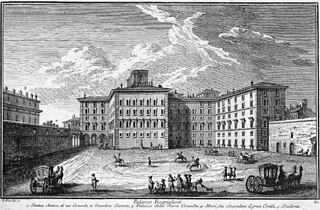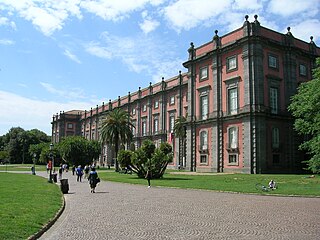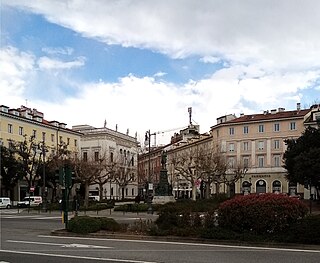The Palazzo Firrao or Palazzo Bisignano, once called Palazzo di Santa Agata, is a monumental palace located on Via Santa Maria di Costantinopoli number 98, facing Piazza Bellini, in central Naples, Italy.
Contents

The Palazzo Firrao or Palazzo Bisignano, once called Palazzo di Santa Agata, is a monumental palace located on Via Santa Maria di Costantinopoli number 98, facing Piazza Bellini, in central Naples, Italy.

A palace at the site existed by the early 1500s, since it is known it once sported external frescoes by Polidoro di Caravaggio. The palace was purchased in the early 17th century by Cesare Firrao, Prince of Sant’Agata and Luzzi, in Calabria. It is generally held that he commissioned the Baroque architect Cosimo Fanzago to rebuild the palace, and that this architect designed the present facade. Others attribute much of the work to Jacopo Lazzari and his son Dionisio. The palace facade was apparently completed by 1630-1640s. [1]
The close affiliation of Firrao to the viceroy's government almost led to the destruction of the palace during the 1647 revolution of Masaniello, but thanks to the intervention of Cardinal Ascanio Filomarino, the palace was spared. Tradition holds that the cardinal was able to dissuade the mobs by pointing to the bust of Charles I of Spain, Holy Roman Emperor, on the facade, and invoking that king's restrained taxation. [2]
The male family of Firrao died out by the second half of the 17th century, and the palace passed through a daughter Livia Firrao, to the line of her husband Tommaso di Sanseverino, Prince of Bisignano. In modern times, it housed government offices. [3]
The base floors of the facade are constructed with rusticated piperno rock, carved with sturdy but tall Ionic pilasters. The ground floor windows are topped with interrupted pediments with decorative urns. The superior tympanum of the portal is flanked by two reclining statues, each with cornucopiae, depicting Magnanimity (with lion) and Charity (with eagle). In the center, below a forward prancing horse, is a shield displaying the heraldic symbols of the Firrao family.
The superior floors also are rich in sculptural elements, with two stories of carved pilasters, the topmost of which are surmounted by symbols of the Firrao family: grapes, lions, and raring horses. But the striking element are the seven medallion niches containing marble busts of rulers of Naples, mostly from the House of Habsburg, which Firrao served. Sculpted by Giulio Mencaglia, perhaps with help from Bernardino Landini and Giuliano Finelli from left to right (not in chronologic order) they depict: Philip IV, Phillip II, Ferdinand II (?), Charles I, Ferdinand III, Philip III and Carlos the Second. [4] [5]

Ca' Rezzonico is a palazzo and art museum on the Grand Canal in the Dorsoduro sestiere of Venice, Italy. It is a particularly notable example of the 18th century Venetian baroque and rococo architecture and interior decoration, and displays paintings by the leading Venetian painters of the period, including Francesco Guardi and Giambattista Tiepolo. It is a public museum dedicated to 18th-century Venice and one of the 11 venues managed by the Fondazione Musei Civici di Venezia.

The Palazzo della Cancelleria is a Renaissance palace in Rome, Italy, situated between the present Corso Vittorio Emanuele II and the Campo de' Fiori, in the rione of Parione. It was built 1489–1513 by Baccio Pontelli and Antonio da Sangallo the Elder as a palace for Raffaele Cardinal Riario, Camerlengo of the Holy Roman Church, and is regarded as the earliest Renaissance palace in Rome.

Pienza is a town and comune in the province of Siena, Tuscany, in the historical region of Val d'Orcia. Situated between the towns of Montepulciano and Montalcino, it is considered the "touchstone of Renaissance urbanism".

The Palazzo Pallavicini-Rospigliosi is a palace in Rome, Italy. It was built by the Borghese family on the Quirinal Hill; its footprint occupies the site where the ruins of the baths of Constantine stood, whose remains still are part of the basement of the main building, the Casino dell'Aurora. Its first inhabitant was the famed art collector Cardinal Scipione Borghese, the nephew of Pope Paul V, who wanted to be housed near the large papal Palazzo Quirinale. The palace and garden of the Pallavicini-Rospigliosi were the product of the accumulated sites and were designed by Giovanni Vasanzio and Carlo Maderno in 1611–16. Scipione owned this site for less than a decade, 1610–16, and commissioned the construction and decoration of the casino and pergolata, facing the garden of Montecavallo. The Roman palace of this name should not be mistaken for the panoramic Villa Pallavicino on the shores of Lake Como in Lombardy. The Palace has also been the scene of important cultural and religious events. On June 6, 1977 Princess Elvina Pallavicini invited in Palazzo Pallavicini Rospigliosi the archbishop monsignor Marcel Lefebvre for a conference on the Second Vatican Council and for the celebration of a Traditiona Mass, under the careful direction of the marquis Roberto Malvezzi, and Frigate Captain marquis Luigi Coda Nunziante di San Ferdinando. Many members of Alleanza Cattolica, the baron Roberto de Mattei, the pharmacologist Giulio Soldani, the sociologist Massimo Introvigne, the psychiatrist Mario Di Fiorino and Attilio Tamburrini and his brother Renato Tamburrini took part to the event.

Carlo Marchionni was an Italian architect. He was also a sculptor and a virtuoso draughtsman, who mixed in the artistic and intellectual circles. He was born and died in Rome.

Ferdinando Fuga was an Italian architect who was born in Florence, and is known for his work in Rome and Naples. Much of his early work was in Rome, notably, the Palazzo della Consulta (1732–7) at the Quirinal, the Palazzo Corsini (1736–54), the façade of the Santa Maria Maggiore (1741–3), and the Church of Sant'Apollinare (1742–8). He later moved to Naples and notably designed the Albergo de'Poveri (1751–81), the façade of the Church of the Gerolamini, and that of the Palazzo Giordano.

Castel Nuovo, often called Maschio Angioino, is a medieval castle located in front of Piazza Municipio and the city hall in central Naples, Campania, Italy. Its scenic location and imposing size makes the castle, first erected in 1279, one of the main architectural landmarks of the city. It was a royal seat for kings of Naples, Aragon and Spain until 1815.

Giuliano da Maiano (1432–1490) was an Italian architect, intarsia-worker, and sculptor, the elder brother of Benedetto da Maiano, with whom he often collaborated.

The Palazzo della Consulta is a late Baroque palace in central Rome, Italy; since 1955, it houses the Constitutional Court of the Italian Republic. It sits across the Piazza del Quirinale from the official residence of the President of the Italian Republic, the Quirinal Palace.

The Chigi Palace is a palace and former noble residence in Rome which is the seat of the Council of Ministers and the official residence of the Prime Minister of Italy. Since 22 October 2022, the tenant of the Chigi Palace has been Prime Minister Giorgia Meloni, although she doesn't live in the building. It is located in the Piazza Colonna, next to Palazzo Montecitorio, seat of the Chamber of Deputies.

The Royal Palace of Capodimonte is a large palazzo in Naples, Italy. It was formerly the summer residence and hunting lodge of the Bourbon kings of the Two Sicilies, one of the two royal palaces in Naples. Today, it comprises the National Museum of Capodimonte and the Royal Forest. The palace was constructed on its somewhat cooler hilltop location just outside the city, with urban Naples ultimately expanding around it.

Neoclassical architecture in Milan encompasses the main artistic movement from about 1750 to 1850 in this northern Italian city. From the final years of the reign of Maria Theresa of Austria, through the Napoleonic Kingdom of Italy and the European Restoration, Milan was in the forefront of a strong cultural and economic renaissance in which Neoclassicism was the dominant style, creating in Milan some of the most influential works in this style in Italy and across Europe. Notable developments include construction of the Teatro alla Scala, the restyled Royal Palace, and the Brera institutions including the Academy of Fine Arts, the Braidense Library and the Brera Astronomical Observatory. Neoclassicism also led to the development of monumental city gates, new squares and boulevards, as well as public gardens and private mansions. Latterly, two churches, San Tomaso in Terramara and San Carlo al Corso, were completed in Neoclassical style before the period came to an end in the late 1830s.

The Palazzo of Monte di Pietà is a historic building located along the lower decumanus of Naples, Italy. The lower decumanus is also known as Spaccanapoli street. It housed the Mount of Piety or Christian bank in Naples.

The Fontana del Gigante or Fountain of the Giant is a 17th-century fountain monument in Naples.

Piazza d'Aracoeli is a square of Rome (Italy), placed at the base of the Capitoline Hill, in the Rione X Campitelli.

The Palazzo Orsini di Gravina is a Renaissance-style palace on number 3 Via Monteoliveto, in the San Lorenzo quarter of Rione San Giuseppe-Carità, of central Naples, Italy. Since 1940, it has housed the Faculty of Architecture of the University of Naples. It is located across the street and a few doors north of the sleek and modern Palazzo delle Poste. Across the street at the north end of the palace, is the Piazza Monteoliveto with its Fountain and the church of Sant'Anna dei Lombardi.

The Piazza Bellini is a plaza located in central Naples, Italy. The Via Santa Maria di Costantinopoli runs along its western side. A block to the south is the Decumanus Maximus.

The Basilica of Santa Maria della Quercia is a Renaissance-style, Roman Catholic sanctuary church and minor basilica, about two kilometer outside of the center of Viterbo, on the road to Bagnaia, in the Region of Lazio, Italy.

The Palazzo di Sangro di Casacalenda is an 18th-century aristocratic palace located across a piazza from the church of San Domenico Maggiore in central Naples, region of Campania, Italy. The East flank of the facade faces the facade of the church of Sant'Angelo a Nilo.

Piazza Venezia is one of the best known squares of Trieste, the capital of Friuli Venezia Giulia, Italy. The square has a view over the Adriatic to the Alps with the Dolomite Mountains Civetta, Monte Pelmo and Antelao. The square is known for its central monument and its prominent buildings and their features: the Revoltella Palace designed by Friedrich Hitzig, with its furnishings and art collection, today including over 350 pieces, the historic Mizzan pharmacy, still conserving the original furnishing, with carved boiserie and fire-worked stained glass windows with mythological images, and the monument of Maximilian I of Mexico, the work of sculptor Johannes Schilling. The square is connected to via Torino, often credited as the center of Trieste's nightlife.